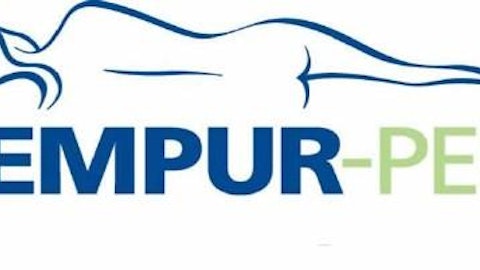For investors looking to play the natural gas industry, some of the best companies are in the oil and gas transport industry. The Energy Information Administration expects U.S. liquid fuels consumption to increase by 0.1% in 2013, after falling 2.1% in 2012. Part of what will drive this is the expected rise in demand for natural gas liquids (NGLs).
There are a number of pipeline companies that operate as master limited partnerships (MLPs). For investors looking to avoid the additional burden come tax filing season (MLPs issue K-1s to investors for tax purposes), there are a few holding companies that operate as corporations and own oil and gas MLPs. These companies provide no extra burden to investors and are similar to owning other corporations, and generally pay a nice dividend. Three such companies are listed below.

Williams Companies, Inc. (NYSE:WMB) is an energy infrastructure company that focuses on connecting North America’s hydrocarbon resource plays to markets for natural gas, natural gas liquids (NGLs), and olefins. Its operations span from the deepwater Gulf of Mexico to the Canadian oil sands, operating in three key segments: Williams Partners L.P. (NYSE:WPZ), Midstream Canada & Olefins and Other. Williams Partners L.P. (NYSE:WPZ) focuses on natural gas transportation, gathering, processing and storage.
Williams Partners L.P. (NYSE:WPZ) contributed more than 90% of Williams Companies, Inc. (NYSE:WMB)’s total 2012 profit. Williams Partners L.P. (NYSE:WPZ) holds most of Williams Companies, Inc. (NYSE:WMB)’s interstate gas pipeline and midstream assets. Furthermore, Williams Partners L.P. (NYSE:WPZ)’spipelines transports 14% of the natural gas consumed in the U.S.
Williams Companies, Inc. (NYSE:WMB)’s midstream assets, which are less sensitive to commodity prices, help the company to maintain a steady stream of revenue and cash flow even if natural gas prices stay low. Furthermore, Williams is poised to benefit from the rebound in industrial activity, which will include increased natural gas demand in the form of natural gas liquids.
Following its capital-intensive WPX Energy spin-off, Williams is now a pure play midstream conglomerate. I think this is a big positive for the company, where the growth in energy infrastructure all across North America should be robust as the industry looks to support the growth of shale plays.
Kinder Morgan Inc (NYSE:KMI) is another way to play the natural gas industry. The company is one of the largest midstream energy companies in North America, operating approximately 73,000 miles of pipelines transmitting natural gas, refined petroleum products, crude oil, carbon dioxide and additional products.
The company owns the general partner (GP) interest and incentive distribution rights (IDRs) of Kinder Morgan Energy Partners, L.P. and El Paso Pipeline Partners, L.P. One of the biggest moves in the industry was the May 2012 acquisition of El Paso Corporation by Kinder Morgan Inc (NYSE:KMI), which created the largest natural gas pipeline system in North America.
Kinder Morgan boosted its quarterly dividend by 19.0% to $0.38 a share from $0.32 paid in the first quarter of 2012. Management has set a dividend target of $1.57 a share for 2013, 12% higher than its 2012 estimate of $1.40 a share, excluding the El Paso acquisition. Kinder Morgan expects to achieve annual dividend growth of 12.5% through 2015.
ONEOK, Inc. (NYSE:OKE) is considered a diversified energy company. At the end of 2012, ONEOK was the sole general partner and owned 43.4% of ONEOK Partners, which is engaged in the gathering, processing, storage and transportation of natural gas in the United States. In addition, ONEOK Partners owns natural gas liquids systems, connecting natural gas liquids (NGL) supply in the Mid-Continent and Rocky Mountain regions with key market centers.
ONEOK, Inc. (NYSE:OKE) Partners is expected to continue being the growth driver of ONEOK, however, ONEOK is looking to expand its internal operations with a $3 billion investment in internal operations. Meanwhile, its 2012 annual dividend of $1.27 per share was up 17.6% from 2011 dividend levels. The company plans to increase its dividend payment by 55% to 65% over 2012 levels before the end of 2015.
Which hedge funds like natural gas?
For Williams, hedge fund SAB Capital took a new position during the fourth quarter of 2012 that was worth $76 million, but the impressive part is that Williams Companies makes up over 11% of SAB’s 13F (public equity) portfolio. ONEOK had billionaire Jim Simons as its top hedge fund owner by market value, with a $46.4 million position, which happened to only make up 0.1% of its 13F portfolio.
Meanwhile, Kinder Morgan had three hedge funds with at least 7% of its portfolio invested in the stock. This includes Locust Wood (after taking a new position during the fourth quarter of 2012) with 7.89% of its 13F, King Street with 7.7% and Halcyon Asset with 7.25%.
By the numbers
From a valuation perspective, Kinder is the cheapest. Kinder trades at 2.9 times book value, while ONEOK is at 4.6 times and Williams is 5.2 times. How do the dividends stack up?
Kinder and Williams Companies pay similar dividend yields, 3.8% and 3.7%, respectively, while ONEOK is at 3%. However,it is worth remembering that all of these companies are corporations (versus LPs), meaning they do not issue K-1s to their investors. This is a positive for investors who would do not want to complicate their tax returns. Yet, for those interested in investing directly in the LPs versus the GPs (Kinder Morgan, ONEOK and Williams Companies) here are how the dividend yields stack up.
Kinder Morgan
- Kinder Morgan Energy Partners (KMP) – 5.9%
- El Paso Pipeline Partners (EPB) – 5.6%
ONEOK
- ONEOK Partners (OKS) – 5.4%
Williams Companies
- Williams Partners (WPZ) – 6.6%
Despite the LPs paying out solid dividend yields, they generally underperform their GPs.

Don’t be fooled
Assuming the natural gas industry shows a rebound, either of the three companies above could reward investors nicely as an income and growth opportunity. What’s more is that Goldman Sachs Group, Inc. (NYSE:GS) recently raised its 2013 natural gas price forecast by 17% — its average estimate for gas prices is now $4.40 per million Btu. I think that Kinder Morgan might be the best bet given its valuation and low payout of operating cash flow at 56%.
The article Betting on Hydrocarbon Infrastructure originally appeared on Fool.com and is written by Marshall Hargrave.
Copyright © 1995 – 2013 The Motley Fool, LLC. All rights reserved. The Motley Fool has a disclosure policy.


